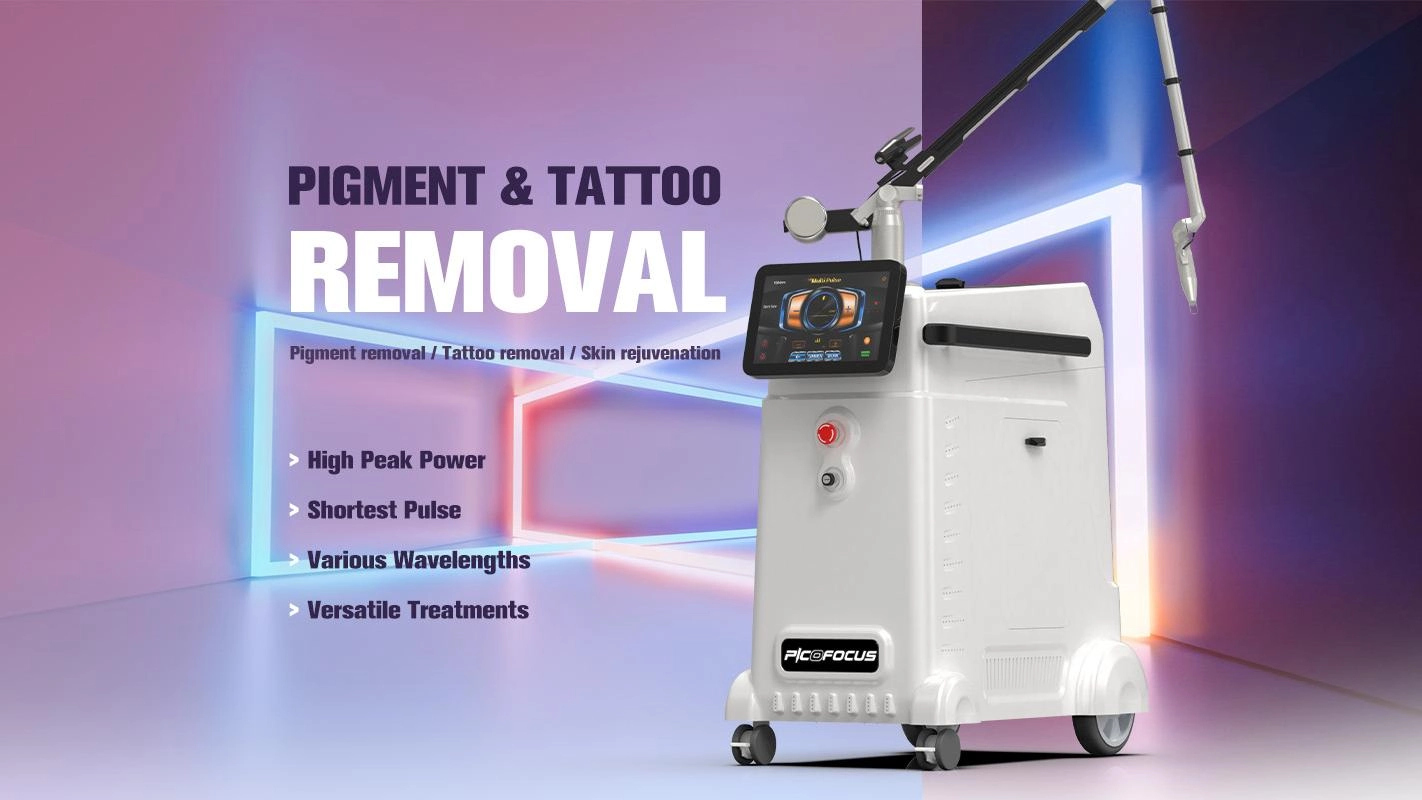In the last ten years, beauty skin care has seen fresh laser advances. A key new tool is the fractional picosecond tip. It turns standard picosecond lasers into strong devices for skin refresh, scar fix, and collagen rebuild. These machines first aimed at tattoo and pigment removal. Their ultra-short pulses make them safer and better for many skin issues, even in darker tones. For sellers or clinic owners looking at new laser systems, this tech offers a money-making, proven choice. It mixes flexibility, safety, and quick patient turnover.

Keypoints
- Forms tiny wounds via sound-wave effects. This sparks fresh collagen with little rest time.
- Works well on Fitzpatrick skin types III–VI. It lowers the chance of dark spots after treatment (PIH).
- Uses Micro-Lens Array (MLA) and Diffractive Optical Elements (DOE). These speed healing and spread energy evenly.
- Gives multi-wavelength options (532 nm, 755 nm, 1064 nm). This allows tailored pigment and refresh treatments.
- Extends picosecond laser value past pigment removal to full skin care uses.
What Is a Fractional Picosecond Handpiece?
A fractional picosecond tip breaks ultra-short laser pulses into tiny beams. It makes controlled skin-deep micro-wounds. These start collagen renewal without harming the top skin layer.
Background and Working Principle
A picosecond laser runs with pulses in the 10⁻¹² second range—one trillionth of a second. It creates pressure waves instead of heat. These waves shatter pigment groups and boost cell renewal. No extra heat damage occurs.
When joined with fractional optics like MLA or DOE, the beam splits into exact micro-areas. These areas cause laser-induced optical breakdowns (LIOBs) in the deep skin. They form tiny repair spots. These prompt collagen rebuild. The top skin stays whole.
This sets fractional picosecond tech apart from flat-beam picosecond systems. Those give even exposure without area control. It also differs from ablative fractional lasers like CO₂ or Er:YAG. Those remove surface skin and need longer healing.
Evolution of Fractional Picosecond Handpieces
The first FDA-cleared picosecond laser came in 2012. It focused on tattoo removal. By 2016, big makers added fractional delivery like MLA and DOE. This shifted from pigment removal to deep skin renewal.
Key steps include:
- Added adjustable spot patterns via MLA for exact micro-beam delivery.
- DOE addition to boost energy evenness and coverage.
- Created variable pulse energy and repeat rate control. This lets users set depth and density.
Today’s top systems mix fractional and zoom tips in one unit. They give flexibility for clinics and sellers wanting multi-use returns.
Clinical Indications and Evidence
Skin Rejuvenation and Pore Refinement
Fractional picosecond lasers treatments start non-ablative collagen and elastin growth. They improve texture, glow, and pore look. Most patients notice change after 3–5 visits. Redness is minor. Rest time is short. It fits regular care plans.
Atrophic Acne Scars
Controlled deep micro-wounds spark scar rebuild and surface smoothing. Studies compare it to fractional Er:YAG. Results match or beat it. PIH risk drops a lot. Healing is faster.
Melasma and Dyschromia
Low-energy fractional picosecond treatments often pair with skin-lightening creams. They cut repeat issues and swelling versus Q-switched lasers. The non-heat method helps darker skin tones most.
Wrinkles and Skin Elasticity
It sends focused energy to deeper skin layers. This tightens skin and straightens collagen fibers. Wavelengths like 755 nm and 1064 nm boost collagen more for medium to deep lines.
Stretch Marks and Photoaging
Early data show gains in stretch marks and uneven color after 4–6 visits. Results build slowly as collagen grows over weeks. Skin gets firmer and more even.
Technological Innovations
Handpiece design keeps growing. It widens what picosecond platforms can do:
- Micro-Lens Arrays (MLA): make evenly spread micro-spots for steady results.
- Diffractive Optical Elements (DOE): provide dense fractional patterns with even energy spread.
- Hybrid systems: combine spot-scanning and fractional modes for full skin resurfacing.
Modern tips now hit pulse widths under 450 ps and peak powers over 1–2 GW. They give stronger effects with less risk. Multi-wavelength swap is now common:
- 532 nm hits surface pigment,
- 755 nm suits melanin-heavy spots,
- 1064 nm reaches deep skin for collagen rebuild.
Safety and Skin Type Considerations
The sound-wave (non-heat) method cuts PIH. It allows safe use on varied skin tones. Studies prove it works and stays safe for Fitzpatrick types III–VI. Use right energy and cooling.
Safety tips include:
- Set energy to match skin reaction,
- Use contact cooling during sessions,
- Apply after-care serums and sun block to speed recovery.
Future Directions
New ideas include AI-guided energy maps. They change pulse energy live based on skin response. Next tips may have depth-varying microlens arrays. These let users target different deep skin layers.
Combo treatments—like RF microneedling, PRP shots, or growth factor creams—show extra gains with fractional picosecond visits. As custom plans grow, clinics get better accuracy, shorter visits, and happier patients.

Fractional picosecond tips have changed picosecond lasers from pigment-only tools to full skin care systems. Their accuracy, speed, and low rest time make them central to modern non-ablative refresh.
Among world makers, Nubway leads in adding multi-wavelength fractional optics and smart energy controls to its picosecond units. This advance lets clinics and sellers manage pigment, scar, and texture fixes with one flexible device. It boosts workflow and returns.
As studies grow, Nubway’s fractional picosecond tech shows how smart light design and proven engineering make pro skin care safer and easier worldwide.
FAQs
Q: What is the main difference between a fractional picosecond handpiece and a regular picosecond laser?
A: A fractional picosecond tip splits the laser beam into micro-areas using MLA or DOE optics. It creates controlled deep micro-wounds. These start collagen rebuild without harming the top skin. A regular picosecond laser gives a flat beam mostly for pigment or tattoo removal.
Q: How many sessions are usually needed with a picosecond machine for visible results?
A: Most patients see clear change after 3–5 visits with a picosecond machine. It depends on goals. For acne scars or deep lines, more visits may help reach best collagen growth and smoother skin.
Q: Is a fractional picosecond handpiece safe for darker skin tones?
A: Yes. It uses sound-wave rather than heat energy. A fractional picosecond tip greatly lowers post-inflammatory hyperpigmentation (PIH) risk. Studies confirm modern systems work safely and well on Fitzpatrick skin types III–VI. Use proper cooling and energy settings.





